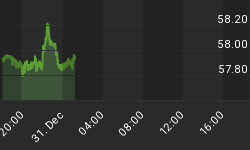The composite indicator constructed from the trends in the CRB Index, gold and yields on the 10 year Treasury is no longer extreme. As prices on the SP500 are above the 40 week moving average, this would be a buy signal as per our strategy that combines this filter with the 40 week moving average.
I last highlighted the indicator on March 1, 2011, and this article was a follow up to an article on February 18, 2011, when the indicator first turned extreme generating a sell signal for the above mentioned strategy. With the indicator extreme, strong and rising trends in the CRB Index, gold and yields on the 10 year Treasury once again proved a headwind for equities over the last month.
Figure 1 is a weekly chart of the SP500 (symbol: $INX) with the indicator in the lower panel. Buy and sell signals from the strategy are on the chart. The value of the indicator is high but not extreme. Per the rules of the strategy this generates a buy signal. Typically, these buy signals, which are occurring at this late stage in a bullish run, are not as robust as those occurring at the start of a price cycle when investors are overly bearish. Gains are not as accelerated. Nonetheless, a buy signal is a buy signal.
Figure 1. SP500/ weekly
The next sell signal will either be 2 consecutive closes below the 40 week moving average or the indicator will move back into the extreme zone.
To review the strategy and its development, please click on these links:
"Developing a Trading Strategy (Part 1)"
"Developing a Trading Strategy (Part 2)"
"Developing a Trading Strategy (Part 3)"
















